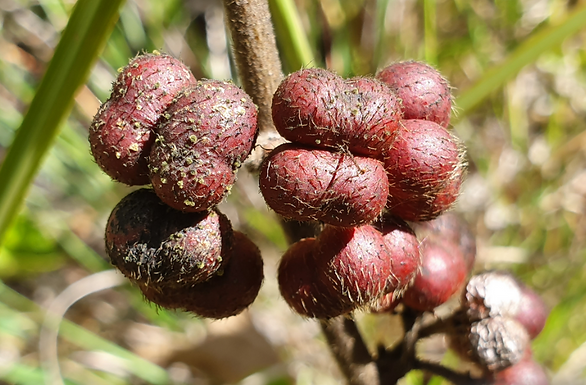Plant identification guides:
Bush tucker food forest
Information about medicinal qualities of plants, or about their use as medicines, is for interest only, and is not intended to be used as a guide for the treatment of medical conditions.
As with all medicinal applications of Australian bush foods, please do your due diligence and consult with First Nations or other Australian herbal specialists before utilising as a remedy for any condition.
Some parts of the plant may not be edible or some may need preparation before they are safe to eat or use in any way. We do our best to describe their traditional & modern uses. It is the reader’s responsibility to ensure they are fit for their intended use.
We can not take any responsibility for any adverse effects from the use of plants. Always seek advice from a professional before using a plant medicinally.
Basic info:
For more information, please see: https://en.wikipedia.org/wiki/Grewia_latifolia
Uses and Interesting Information:
A resilient dry-country shrub with sweet, tangy fruits enjoyed by Indigenous Australians and eagerly sought by emus. The fruit was eaten fresh, mashed into drinks, or dried into travelling cakes, while the strong inner bark was used for string and nets. A key wildlife food and fire-resilient species, Grewia forms an important part of Australia’s traditional bush-tucker landscape.
Indigenous Uses
1. Fruit – an important bushfood in northern Australia
The fruit was eaten widely by Indigenous groups across northern and eastern Australia.
Eaten fresh when soft and purple-brown
Slightly sweet, tangy, sometimes resinous
Often described as berry-meets-date with a hint of tamarind
Fruits were sometimes collected in large amounts and carried in dilly bags.
2. Fruit pulp for drinks & pastes
The soft ripe pulp was:
Mashed with water to make a refreshing drink
Mixed with other fruits to create a more complex flavour
Pressed into cakes or balls to dry in the sun for later use
These dried fruit cakes were valued as traveller’s food.
3. Medicinal uses
Traditionally used for:
Stomach upset (chewed fresh or taken as a mild infusion)
Low-level diarrhoea relief (due to natural tannins)
Mouth and gum issues, chewing the fruit for its soothing quality
The bark and roots of some Grewia species were also used as:
Antiseptic washes
Wound cleansers
Anti-inflammatory infusions
4. Fibre – strong inner bark
The inner bark fibres of Grewia species are famously strong and were used for:
String and cordage
Nets
Fish traps
Tying tools
Making woven bags
This makes Grewia latifolia both a food and a utility plant.
Stories, Culture & Interesting Lore
1. A fruit loved by emus and humans
Emus adore the fruit, and Indigenous people often observed birds feeding first to determine:
Ripeness
Seasonal abundance
Locations of heavy-bearing shrubs
Bird tracks around Grewia shrubs signalled good foraging.
2. A seasonal marker
The ripening of Grewia fruit often aligned with:
Early dry season in the north
Transition periods between food abundances
Shifts in wildlife movement
This made it a calendar plant in some ecologies.
3. A plant of resilience
Grewia species withstand:
Fire
Drought
Harsh soils
For this reason, Elders sometimes described it as a “hard country survivor” — teaching lessons about endurance and adaptation.
4. A favourite of children
Because fruit is easy to pick and sweet, children often collected it during day trips and foraging walks. Some stories describe the fruit as “bush lollies of the dry country.”
Modern Uses
1. Culinary
Though still underappreciated in mainstream bushfood cuisine, Grewia latifolia fruit can be used in:
Jams
Chutneys
Fruit leathers
Cordials
Compotes
Blended berry pastes
Fermentations (mild, tangy drinks)
Its flavour pairs well with:
Lemon myrtle
Davidson plum
Rosella
Native ginger
Honey
2. Landscaping
Excellent for:
Dry bush-tucker gardens
Wildlife gardens
Drought-resilient landscapes
Revegetation in sandy or rocky soils
Grows as a tidy small shrub with attractive leaves and plentiful fruit.
4. Fibre demonstrations
The bark fibres offer excellent opportunities for:
String-making workshops
Bushcraft lessons
Hands-on weaving activities
A beautiful way to show visitors the practical skills of traditional living.
Ecological Importance
Major wildlife food source
Eaten by:
Emus
Wallabies
Possums
Fruit-eating birds
Rodents
Helps sustain animals in dry seasons when few other fruits are available.
Seed dispersal
Emus in particular spread Grewia seeds long distances, contributing to:
Healthy shrub distribution
Gene flow
Post-fire recolonisation
Fire ecology
Resprouts after fire
Fruits heavily the season after burns
Helps stabilise soils in post-fire landscapes
Habitat role
Provides:
Shelter for small birds
Food for insects
Browsing for herbivores
Recipes:

